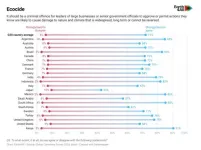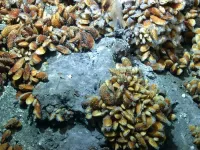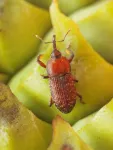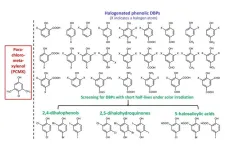(Press-News.org) COLUMBUS, Ohio – Severe drought in the American Southwest and Mexico and more severe wet years in the Northeast are the modern norm in North America, according to new research – and the analysis suggests these seasonal patterns will be more extreme in the future.
The middle of the United States, meanwhile, can expect bigger swings between wetter wet periods – high-rainfall years known as pluvials – and drier summers through the rest of this century, the study predicts.
Researchers at The Ohio State University say the findings, based on modern precipitation data, historical tree rings and climate models spanning the years 850 to 2100, suggest climate change has shifted precipitation patterns across North America to extremes that were not experienced before industrialization began around the mid-1800s.
“It’s very much a tale of Southwest versus the Northeast for most of the seasons,” said senior author James Stagge, assistant professor of civil, environmental and geodetic engineering at Ohio State. “Mexico and the American Southwest tends to get drier across more or less all seasons, whereas we’re seeing in the Northeast – and Ohio is included in that – a trend toward wetter, particularly in the winter and early spring.”
The combination of drier droughts and wetter pluvials in much of the nation’s midsection won’t necessarily occur in a predictable way.
“So you might be going from, say, this year our drought is really bad, and in five years or so we might see the wettest pluvial we’ve had in a while,” Stagge said. “That variability is concerning because it changes how we might need to manage water to prepare for more extremes in both ways. Trying to plan for that is a real challenge.
“This is all part of the same pattern moving into the future. It’s only going to get worse.”
Former Ohio State graduate student Kyungmin Sung, now a research fellow at the Korea Environment Institute, is first author of the paper. The research is published today (Sept. 6, 2024) in Geophysical Research Letters.
In contrast to attribution studies that examine whether or how human-associated climate change has influenced extreme weather events, this work focused on documenting centuries-long trends in pre- and post-industrial drought and pluvial extremes across North America.
The researchers compared changing climate patterns observed in the past 20 years to the pre-industrial era and then predicted how periods of low and high precipitation will trend through the year 2100.
“What we can say is, ‘here is the scale of change we’ve seen in the past 100 years under an increase in greenhouse gas concentration, and here’s what we saw in the previous 700 years,’” Sung said. “And the scale of the change we’re seeing now and into the future is dramatically larger in many areas than any natural climate variability we saw prior.”
The researchers merged data from five sources: two modern compilations of precipitation observations, tree ring reconstructions from the distant past, and two climate models – each covering the same historical period as the tree ring analyses and continuing to predict future extreme dry and wet trends with increasing greenhouse gases.
The integration of different data types lends credibility to the findings, Stagge said: “A benefit of having very different types of data is they can fill in each other’s gaps. We consider trends to be significant only when they’re showing up across multiple data sets – so that increases our confidence.”
Maps of the changing climate patterns show the method produced smooth spatial transitions and obvious boundaries, suggesting that “what we’re seeing is real,” he said.
While the drying of the West is a well-known phenomenon, the team was surprised to see how extensive the precipitation increase has been and will be in the Northeast and how dramatic the heightened variability from droughts to pluvials is going to be in the center of the country.
These patterns of water shortages and gluts could affect industries ranging from farming to construction and city planning, and are likely to strain management efforts to maintain household water-source reservoirs at optimum levels.
“Planners, government agencies and engineers want to do the right thing and plan for a potentially changing climate, but oftentimes they don’t necessarily have the numbers or the broader picture of what’s going to be happening where,” Stagge said. “This puts regions on notice. In the Southwest, you’re going to have less water to deal with, and if you’re managing a farm in the middle of the country you might be seeing wider swings between droughts and pluvials.
“Certainly, we’d like to arrest further climate change, but it takes a long time to turn that ship,” he said. “In the meantime, we should be planning on where we’re headed to decrease impacts on people, the economy and the environment.”
This work was supported by the National Science Foundation, the Byrd Polar and Climate Research Center at Ohio State, and the Ohio Supercomputer Center. Gil Bohrer of Ohio State was also a co-author of the paper.
#
Contact: James Stagge, Stagge.11@osu.edu
Written by Emily Caldwell, Caldwell.151@osu.edu; 614-292-8152
END
The medical field is inherently susceptible to errors, with laboratory tests being no exception. In histopathology laboratories, where tests are considered the gold standard for diagnosing various diseases, errors can significantly impact patient outcomes. Quality Control (QC) and Quality Assurance (QA) programs are essential in minimizing these errors and ensuring the generation of accurate and reliable reports. The complex, multistep nature of histopathology work, combined with the subjective nature of many diagnostic interpretations, ...
Nearly three out of four people (72%) surveyed across 18 G20 countries1 support making it a criminal offence for government or leaders of large businesses to approve or permit actions which cause serious damage to nature and climate, finds major new research. This finding is part of the latest Global Commons Survey 2024, conducted by Ipsos UK and commissioned by Earth4All and the Global Commons Alliance (GCA).
The research follows recent landmark legislative changes, including in Belgium where ecocide was recognised as a federal crime earlier this year. Related laws ...
Newborn babies have one of three pioneer bacteria in their gut shortly after birth, one of which could be used to develop new personalised infant therapeutic probiotics, researchers show.
In the largest study of UK baby microbiomes to date, researchers from the Wellcome Sanger Institute, University College London (UCL), and the University of Birmingham, used whole genome sequencing to analyse stool samples from 1,288 healthy infants, all under one month old from the UK Baby Biome Study1.
This research, published today (6 September) ...
Most animals live in intimate relationships with bacteria. Some of these bacteria live inside the cells of their hosts, but only very few are able to live inside cell organelles (structures inside the cell, like organs in the body). One group of bacteria have figured out how to colonize the nuclei of their hosts, a remarkable feat given that the nucleus is the control center of the cell.
To date, nothing is known about the molecular and cellular processes that these intranuclear bacteria use to infect and reproduce in animal hosts. A group of scientists from the Max Planck Institute for Marine Microbiology in Bremen, Germany, now presents the first in-depth analysis ...
Thermogenesis is a process by which organisms generate internal heat. Although it is usually associated with animals, some plants have also developed this ability. This metabolic process allows certain parts of the plant, such as flowers and inflorescences, to raise their temperature above that of the surrounding environment. Today, these plants, which include cycads and some angiosperms (flowering plants), rely on insects for pollination. The heat they generate helps volatilize and disperse floral fragrances and other chemical compounds that attract insects such as beetles, flies, and ...
They’re tiny drug-delivery systems 1000 times smaller than a human hair, but while nanomedicines have long been hailed as the future for treating debilitating and life-threatening diseases, their journey from lab to patient has many challenges.
Now, new findings from a global team of expert scientists in academia and industry has generated world-first research quality standards that will help slash costs and reduce the time it takes to develop advanced nanomedicine treatments and make them available for patients.
Published in Nature Nanotechnology today, and led by the University of South Australia’s Dr Paul Joyce and the University ...
If this galaxy is typical, then the study, published today in Nature Astronomy, indicates that our galaxy is already interacting with its closest neighbour, Andromeda.
Where does a galaxy end and deep space begin? It seems like a simple question until you look more closely at the gas that surrounds galaxies, known as the circumgalactic medium.
The halo of gas surrounding the stellar disc accounts for about 70% of the mass of the galaxy – excluding dark matter – but until now has remained something of a mystery. In the past we have only been able to observe the gas by measuring the light from a background object, ...
Dark matter is the invisible force holding the universe together – or so we think. It makes up around 85% of all matter and around 27% of the universe’s contents, but since we can’t see it directly, we have to study its gravitational effects on galaxies and other cosmic structures. Despite decades of research, the true nature of dark matter remains one of science’s most elusive questions.
According to a leading theory, dark matter might be a type of particle that barely ...
A widely used disinfectant worldwide, chloroxylenol, has been associated with eco-toxicological threats in water environments due to its relatively high chemical stability and massive consumption. Researchers at the School of Engineering of the Hong Kong University of Science and Technology (HKUST) have discovered a promising alternative known as 2,6-dichlorobenzoquinone (2,6-DCQ), which works more effectively in combating certain common bacteria, fungi and viruses, and can be rapidly degraded and detoxified in receiving waters.
This groundbreaking study is led by Prof. ZHANG Xiangru from HKUST's ...
In some places around the globe, the lights never go off. Streetlights, roadway lighting, and illuminated signs can deter crime, make roads safer, and enhance landscaping. Undisrupted light, however, comes with ecological, behavioral, and health consequences.
In the US, some states have legislation in place to reduce light pollution; however, levels of light at night remain high in many parts of the country. Now, researchers there have investigated correlations between outside nightly light pollution and Alzheimer's disease (AD).
“We show that in the US there is a positive ...




